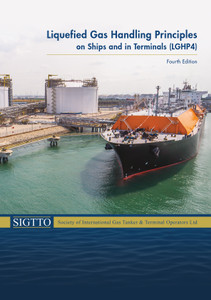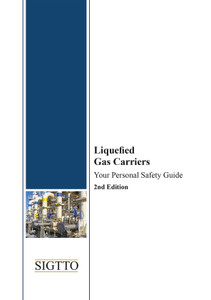
This is a guide to the transfer of Liquefied Petroleum Gas (LPG) between Floating (Production) Storage and Offloading (F(P)SO) facilities and conventional gas tankers. It covers every stage of the operation, including pre-arrival procedures, berthing and mooring, cargo transfer, unmooring and departure, gas-up and cooldown. It also discusses operational and personnel safety and emergency preparedness.
This publication primarily addresses side by side (SBS) operations where the gas tanker moors alongside the F(P)SO. It includes recommendations for mooring equipment and considers mooring loads and operations, motions of the F(P)SO and gas tanker, station keeping, cargo transfer equipment and cargo transfer operations. The guidelines are intended to assist in standardising equipment and procedures for SBS activities and to highlight general design issues in the interest of safe, efficient and reliable operations.
Purpose and Scope
These Guidelines address the transfer of Liquefied Petroleum Gas (LPG) between Floating (Production) Storage and Offloading facilities (F(P)SOs) and conventional gas tankers. Offshore operations involving the transfer of Liquefied Natural Gas (LNG) are not specifically addressed in this document, but will be included in a future update once industry experience is available on which to base guidance.
The Guidelines are primarily intended to familiarise Masters, ship operators, F(P)SO operators and project development teams with the general principles and equipment involved in LPG offloading activities between F(P)SOs and gas tankers. For the purposes of these Guidelines, the gas tanker is considered to be a vessel equipped with standard mooring and cargo transfer equipment, with a conventional single propulsion system comprising of a fixed blade propeller.
The guide primarily addresses side-by-side (SBS) operations where the gas tanker moors alongside the F(P)SO. LPG is also offloaded to gas tankers offshore in other modes, such as via an SPM or in a tandem configuration. These operations are considered in depth in other OCIMF publications associated with oil transfers. Within this publication, only the differences associated with gas transfer have been highlighted.
To address site-specific aspects in particular locations, the recommendations contained within this publication may be supplemented by additional requirements from development project teams, individual ship owners (or ship managers) and individual F(P)SO operators.
Individual countries may have local regulations that address mooring arrangements and LPG cargo transfer operations within their territorial waters or Exclusive Economic Zone. These must be complied with and, where appropriate, these Guidelines may be referenced for additional advice. These Guidelines should not be considered contrary to, or a replacement of, any National or International Regulations or individual terminal operator’s specific procedures.
Section 1
Regulatory Compliance
1.1
General
1.2
Coastal
State/Local
Requirements
1.3
Flag
State
Requirements
1.4
Classification
Society
Requirements
1.5
Other
Industry
Guidance
Section
2
Safety
in
Design
2.1
General
2.2
Risk
Analysis
2.3
Operating
Environments
2.4
Model
Tests
and
Simulations
2.5
Tug
Support
2.6
Berthing
Aids
2.7
F(P)SO
Mooring
System
2.8
F(P)SO
Heading
Control
2.9
Mooring
Equipment
Layout
Configuration
and
Compatibility
2.10
Fendering
Equipment
2.11
Cargo
Transfer
Equipment
2.12
F(P)SO
Venting
Systems
2.13
ESD
Systems
2.14
Emergency
Release
Couplings
2.15
Quick
Release
Capability
of
Moorings
2.16
Lighting
2.17
CCTV
Section
3
Operational
and
Personnel
Safety
3.1
Operational
Safety
3.2
Personnel
Safety
Section
4
Nomination
and
Pre-Arrival
Procedures
4.1
Nomination
Procedures
4.2
Pre-Arrival
Communications
4.3
Pre-Arrival
Checklists
and
Testing
of
Essential
Systems
4.4
Tugs
and
Support
Vessels
4.5
Mooring
and
Fendering
Plan
Section
5
Berthing
and
Mooring
5.1
Personnel
and
Equipment
Transfer
5.2
Pre-Berthing
Inspection
5.3
Pre-Berthing
Information
Exchange
5.4
Pre-Berthing
Equipment
Checks
5.5
Use
of
Tugs
5.6
Berthing
Criteria
5.7
Manoeuvring
5.8
Mooring
5.9
Transfer
of
Personnel
and
Equipment
Alongside
5.10
Orientation
of
F(P)SO
for
SBS
Operations
Section
6
Cargo
Transfer
6.1
General
6.2
Cargo
and
Ballast
Plans
6.3
Pre-Transfer
System
Integrity
Checks
6.4
Hose/Arm
Handling
and
Connection
6.5
Sampling
and
Gauging
6.6
Cargo
Transfer
6.7
Control
of
Vapours
6.8
Hose/Arm
Clearing
6.9
Hose/Arm
Disconnection
and
Recovery
Section
7
Unmooring
and
Departure
7.1
Early
Departure
Procedure
7.2
Unmooring
and
Departure
Section
8
Gas-Up
and
Cool-Down
8.1
General
8.2
Gas
Tanker
8.3
F(P)SO
Section
9
Offshore
Transfer
of
LPG
via
Tandem
Mooring
or
SPM
9.1
Primary
References
and
Scope
9.2
Safety
in
Design
9.3
Operational
Issues
Section
10
Emergency
Preparedness
10.1
Overview
10.2
Emergency
Scenarios
10.3
Drills
and
Training
Appendices
A
Example
Content
of
Terminal
Handbook
(Port
Information
Book)
B
Example
SIMOPS
Matrix
C
Example
Gas
Tanker
Nomination
Questionnaire
D
Checklists
D1
Example
Record
of
Pre-Transfer
Meeting
D2
Example
of
F(P)SO
Pre-Berthing
Checklist
D3
Example
of
Ship/F(P)SO
Safety
Checklist
D4
Example
Pre-Unberthing
Checklist
The Oil Companies International Marine Forum (OCIMF) is a voluntary association of oil companies with an interest in the shipment and terminalling of crude oil, oil products, petrochemicals and gas. OCIMF focuses exclusively on preventing harm to people and the environment by promoting best practice in the design, construction and operation of tankers, barges and offshore vessels and their interfaces with terminals. Learn more at: www.ocimf.org
- Number of Pages:
- 116
- ISBN:
- 9781856094009
- Binding Format:
- Hardback
- Book Height:
- 300 mm
- Book Width:
- 215 mm
- Weight:
- 0.9 kg
- Author:
OCIMF
- Published Date:
- October 2010
- Preview:
- Yes
- Publication Date:
- October 2010





